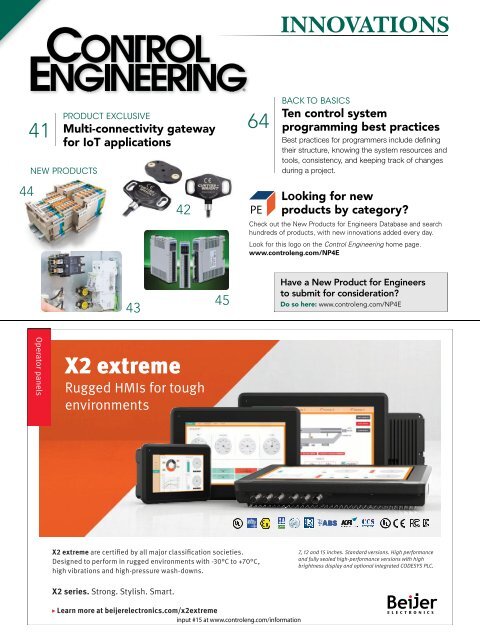Control Engineering - January 2018 (R) 'I'
Revista Control Engineering
Revista Control Engineering
Create successful ePaper yourself
Turn your PDF publications into a flip-book with our unique Google optimized e-Paper software.
ANSWERS<br />
INSIDE PROCESS: VFDS<br />
Jason Wellnitz, Yaskawa America Inc.<br />
Three major VFD trends<br />
Variable frequency drive (VFD) development is shifting focus away from<br />
general-purpose motor controls that are already meeting market demands<br />
toward reduced installation costs.<br />
More than 40 years ago, transistor-based<br />
variable frequency drives (VFDs) quickly<br />
demonstrated their ability to save<br />
energy and improve process control.<br />
Successive VFD generations improved motor-control<br />
performance, became smaller, and minimized installation<br />
time. VFD development is shifting focus away<br />
from general-purpose motor controls that are already<br />
meeting market demands toward one remaining constant<br />
market driver: reduced installation costs.<br />
1. Save time<br />
To minimize commissioning time, VFDs are being<br />
designed and built for individual industries. Out-ofthe-box<br />
VFDs are programmed with industry-specific<br />
terminology, parameter defaults are customized, new<br />
functions created, and unneeded features are cut away.<br />
VFDs also are being programmed with industry-specific<br />
setup wizards to guide the installer through the<br />
typical steps needed to run a drive (see image).<br />
These software features are designed to minimize<br />
the installer’s time in front of a drive at the job site to<br />
reduce commissioning costs. A second benefit of creating<br />
industry-specific drive features is to minimize<br />
the time required to train drive installers by making<br />
drive setup intuitive and easier.<br />
2. Save space<br />
Open-type and NEMA 1 VFD enclosures<br />
are still the staple of VFDs manufactured in the<br />
PROTECT PUMPS<br />
DRY RUNNING • CAVITATION • BEARING FAILURE • OVERLOAD<br />
MONITOR PUMP POWER<br />
• Best Sensitivity<br />
• Digital Display<br />
TWO ADJUSTABLE SET POINTS<br />
• Relay Outputs<br />
• Adjustable Delay Timers<br />
4-20 MILLIAMP ANALOG OUTPUT<br />
COMPACT EASY MOUNTING<br />
Only 3.25" x 6.25" x 2"<br />
• Starter Door • Panel<br />
• Raceway • Wall<br />
UNIQUE RANGE FINDER SENSOR<br />
• Works on Wide-range of Motors<br />
• Simplifi es Installation<br />
WHY MONITOR POWER INSTEAD OF JUST AMPS?<br />
PUMP POWER<br />
VALVE CLOSING<br />
POWER<br />
Power is Linear-Equal Sensitivity<br />
at Both Low and High Loads<br />
AMPS<br />
No Sensitivity<br />
For Low Loads<br />
PUMPING<br />
VALVE OPENING<br />
NO FLUID<br />
NO LOAD<br />
FULL LOAD<br />
NO LOAD<br />
FULL LOAD<br />
WWW.LOADCONTROLS.COM<br />
CALL NOW FOR YOUR FREE 30-DAY TRIAL 888-600-3247<br />
input #13 at www.controleng.com/information


